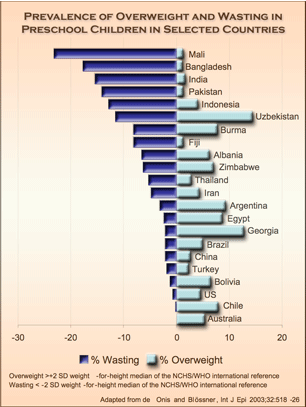CECHE  Center for Communications, Health and the Environment
Center for Communications, Health and the Environment
 Center for Communications, Health and the Environment
Center for Communications, Health and the Environment 
Curbing the Obesity & Undernutrition Epidemic
Could Forestall Major Assault on Global Health
Could Forestall Major Assault on Global Health
by Prof. Boyd Swinburn, Centre for Physical Activity and Nutrition Research,
Deakin University, Melbourne, Australia

Undernutrition On the Wane
Childhood undernutrition, or malnutrition, is a chronic problem in lower-income countries. A high prevalence (>40%) of stunting in children is present in sub-Saharan Africa and many countries in South-Central and Southeast Asia, while low (<20%) and moderate (20-30%) rates are seen in the majority of Latin American and Caribbean nations. Thankfully, in all developing countries combined, the prevalence of stunting has dropped considerably, from nearly 50 percent in 1980 to 30 percent in 2000, and it is projected to fall to about 16 percent by 2020. Unfortunately, African nations continue to suffer severely, with only about a 5 percent decline from 1980 to 2000.
Emerging Patterns of Obesity in Childhood
At the same time, levels of obesity are increasing, particularly in higher-income countries and within the wealthier (often urban) populations of low- to middle-income nations. Increases in childhood obesity usually occur some time after upsurges in adult obesity, although there are exceptions. In China, for example, the household pattern of lean parents and grandparents but overweight children is not uncommon. The developing countries with the highest prevalence rates for obesity are the Middle East, North Africa and Latin America.
In some countries, such as many Pacific nations, the prevalence rates of both childhood obesity and undernutrition are low; however, adult obesity is extremely prevalent, and therefore children can expect to gain 1 to 2kg per year during the decade after they leave school.
Coexistence of Malnutrition and Obesity
Malnutrition and obesity coexist in many developing nations. This high double burden (>5% prevalence rates of each among pre-school children) is seen in such diverse countries as Yemen, Uzbekistan, Kiribati, Burma, Albania, Zimbabwe and Malawi. While the majority of overweight children come from urban environments and higher-income families, malnutrition and obesity may, and often do, occur within the same family.
Even in wealthy countries, such as Australia and the United States, where childhood obesity is very common (one-quarter to one-third of all children), there are significant pockets of malnutrition. This is the result of food insecurity – a condition defined by periods of not having enough money to buy food, and one that is increasingly experienced among disenfranchised people, especially migrant populations. A recent childhood nutrition survey in New Zealand, for example, found that more than one-fifth of households reported “running out of food due to lack of money” either “sometimes” (18.5%) or “often” (3.6%).
Except for cases of extreme poverty or poor access to food, undernutrition of total energy is generally not a problem in these wealthier nations; nevertheless, children and adolescents from low-income families in these countries often exhibit higher prevalence rates of obesity, micronutrient deficiency (or inadequate intake) and episodes of food insecurity. So, two apparent paradoxes exist in these “lands of plenty”: significant levels of food insecurity and higher prevalence rates of obesity (and micronutrient deficiency) among people who experience food insecurity.
Responding to the New Childhood Nutrition Challenges
Even within wealthier countries, where the childhood obesity epidemic has been brewing for at least a decade, awareness of the need for action is only now gaining ground with the politicians, media and public. Under-recognition of the problem by parents and health professionals, and the sensitivities of discussing childhood obesity are significant barriers to action. Meanwhile, evidence of the effectiveness of potential interventions and programs is sorely lacking.
Within low-income countries plagued by chronic undernutrition, some of the systems used to manage this scourge (e.g., monitoring the height and weight of children, maternal nutrition and education programs) could, in theory, also be used to help address the obesity problem. However, the momentum of these initiatives and their orientation towards feeding programs to increase energy intake may be counterproductive if these efforts cannot be re-configured to address both undernutrition and the emerging obesity problem.
A further challenge is the positive perception that many cultures have of being overweight or obese. In Africa, for example, a large belly is often viewed as a sign of wealth and health because its owner clearly has enough money to buy plenty of food and doesn’t harbor diseases such as HIV, AIDS or tuberculosis.
Much needs to be done to manage childhood malnutrition and obesity, and most countries – rich and poor alike – would do well to heed the call. To do so in a meaningful way will require these nations to allocate program resources, institute proactive primary-prevention policies and substantially increase monitoring mechanisms. {